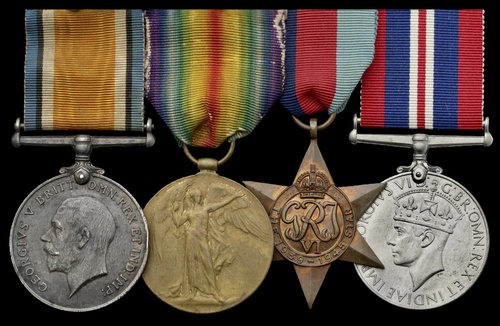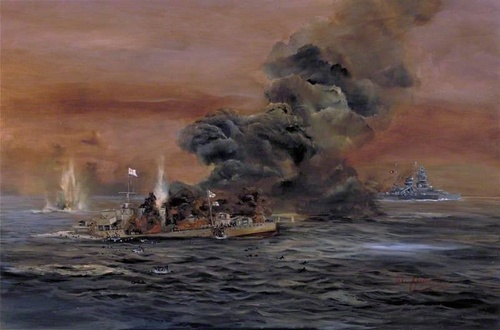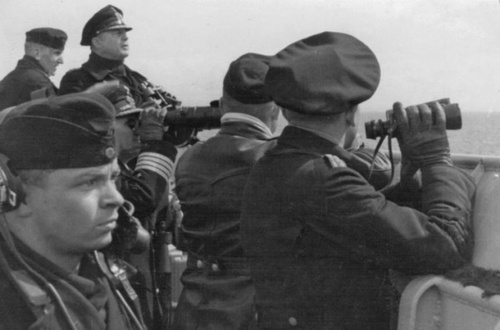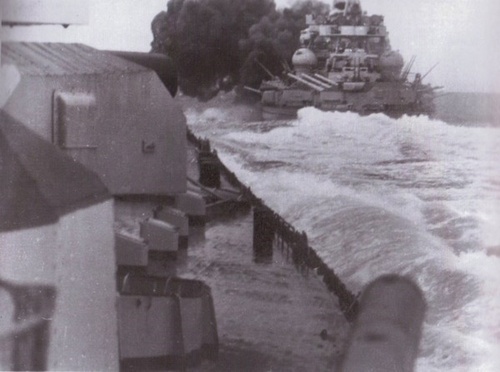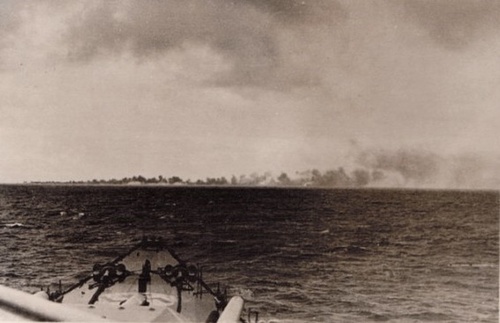Auction: 22003 - Orders, Decorations and Medals
Lot: 390
'Not only the tactical handling but the audacity and pluck of the destroyers was outstanding. Every officer taking part in the action was of the same opinion. The destroyers put their utmost into the task, although, in their position, success was impossible from the start.'
Commander Schubert of the Scharnhorst pays tribute to the extraordinary gallantry displayed by men of the destroyers Acasta and Ardent, in their efforts to defend the ill-fated aircraft carrier Glorious on 8 June 1940.
The poignant Great War and Second World War campaign group of four awarded to Able Seaman L. J. Cornish, Royal Fleet Reserve, late Royal Navy, who was killed in action in the destroyer H.M.S. Acasta's remarkable 'David and Goliath' encounter with the Scharnhorst and Gneisenau off Norway on 8 June 1940
In a desperate last act to protect the aircraft carrier Glorious, Acasta closed the mighty Scharnhorst, in the face of a torrent of fire, and delivered a crucial torpedo strike, a strike subsequently described by one senior officer as 'one of the finest of many heroic incidents of the War'
The damage to Scharnhorst was indeed substantial and the ship took on 2,500 tons of water: 53 German sailors drowned in her compartments - deliberately flooded compartments - to correct the Scharnhorst's severe list, and she was compelled to withdraw to Trondheim
Commander Schubert's respect for the gallant nature of Acasta's suicidal - yet successful - torpedo attack was shared by his compatriots in the Gneisenau: her battle ensign was lowered to half-mast and her crew brought to attention to honour Acasta's crew
The battle was over in less than two hours, Glorious, Acasta and Ardent all being sunk: 600 men were killed and 900 left adrift in life rafts, of whom only 41 survived
Acasta's commanding officer was subsequently recommended for a posthumous award of the V.C., a recommendation shamefully denied him - and his crew - on account of the ongoing controversy surrounding the damaging loss of the Glorious
British War and Victory Medals (J. 40902 L. J. Cornish, A.B., R.N.); 1939-45 Star; War Medal 1939-45, the Great War medals mounted as worn, nearly very fine, the Second World War awards extremely fine (4)
Leslie James Cornish was born in Dorking, Surrey on 14 June 1899 and entered the Royal Navy as a Boy 2nd Class in June 1915.
Having then attended shore-based training establishments, he first went to sea in the cruiser H.M.S. Centaur, in the period July 1916 to January 1918, and afterwards in another cruiser, the Curacoa, from January 1918 to June 1919, in which period she served in the Baltic and was mined off Reval. He then came ashore as an Able Seaman in June 1929, when he enrolled on the strength of the Royal Fleet Reserve.
Journey's end - H.M.S. "Acasta" - Norway 1940
Just prior to the renewal of hostilities, in August 1939, Cornish was mobilised in his capacity as an Able Seaman in the Royal Fleet Reserve and joined the destroyer H.M.S. Acasta. It was to prove his final appointment for, as cited above - in an astonishing act of self-sacrifice to protect the aircraft carrier Glorious - he and his crew took-on the mighty Scharnhorst and Gneisenau at point-blank range off Norway on 8 June 1940.
It became one of the most memorable naval encounters of the Second World War, a story imbued with great courage and, to this day, one which is surrounded by controversy. But for the purposes of this catalogue entry, it is pertinent to return to the words of Commander Schubert of the Scharnhorst, who undoubtedly felt the sharp end of Acasta's suicidal torpedo attack:
'The destroyer with the carrier [H.M.S. Acasta] turned to the attack on the battleships, who took avoiding action. At this stage of the fight, at about the time of the capsizing of the carrier, the Scharnhorst received a torpedo hit on the starboard side level with the after main turret. As was ascertained later, the hole torn in the ship's side was of considerable dimensions. The hit immediately affected the main turret magazines, the turret starting to burn. The starboard engine went out of action; the starboard propeller-shaft together with the bearings was torn away from the hull. A great deal of water entered the ship; her position became difficult, the more so as the midships engine-room was gradually filling with water.
The ship however continued the fight with the now very severely damaged destroyer. The latter fought on in a hopeless situation with her far inferior armament against the battleships. She achieved, so far as I can remember, one light hit against the centre barrel of No. 2 main turret.
The carrier had in the meantime capsized, and the place where she went down lay far astern of the ship. When the destroyer ceased firing on her armament being put out of action, the battleships did so too. The heavily damaged condition of the Scharnhorst made it imperative to see to the return of the damaged ship to the nearest Norwegian harbour, and to put the measures necessary for this in hand immediately … '
As it transpired, of Acasta's ship's company of 161 men, there was only one survivor: Nick Carter.
In 1973, John Austin recorded Carter's experiences in his book, The Man Who Hit the Scharnhorst: The Ordeal of Leading Seaman Nick Carter. One book review stated:
'It is a vivid, moving and thought-provoking account of a deeply tragic and very controversial episode in the history of the Royal Navy, which places very intense personal recollections from a survivor of the battle in the context of a review of the events surrounding the Norwegian campaign. Austin's research has been very thorough, examining numerous sources available at that time (Admiralty files relating to this incident were only made public in 1993), but he never loses sight of the most important aspect in this work: the human story.
British warships had been routinely moving, unhindered by enemy warships, to and from Norway; the independent sailing of the aircraft carrier Glorious and her two escorts should have been no exception. Unfortunately, two German battleships, Scharnhorst and Gneisenau, were part of a force ordered to attack Allied shipping in Norwegian waters. At about 4 p.m. on 8 June 1940, now operating alone, Scharnhorst and Gneisenau sighted Glorious, Ardent and Acasta.
The British ships quickly came under attack from the enemy. Ardent carried out a torpedo attack and was sunk; despite a smokescreen laid down by the destroyers, Glorious came under withering fire from the Germans and was reduced to a blazing pyre; soon, only Acasta remained as an effective fighting unit, protected by her own smokescreen, steaming at full speed away from the enemy.
Austin's well-paced, third-person prose places the reader with both feet set squarely on the heaving deck of H.M.S. Acasta, in the heat of that battle.
He heard the whistling salvoes come again. Glorious was a real mess. Flame spouted from her quarterdeck and curled over the edge of the flight deck. She was blazing along her whole length, listing badly to port and circling slowly. Clearly she couldn't last. Nor would they if they didn't move fast. They moved all right. He had never known Acasta go so fast; better than 38 knots, he reckoned, and with the paint blistering from her funnels. Past the crippled Glorious they swept, trailing blue-black smoke, rapidly widening the gap between Acasta and the enemy. Go on Stokes, stoke it up mate. We don't want to join the poor old Ardent.
Yet at the same time he was surprised, even a little ashamed. It made sense to run away, of course, but somehow the Old Man didn't seem that sort.
The "Old Man", Acasta's captain, Commander Glasfurd, having decided in fact to launch a torpedo attack, addressed the ship's company:
Faintly, Nick heard the calm voice of Commander Glasfurd:
"You may think we are running away from the enemy. But the Navy never does. The Glorious is sinking, and our chummy ship, the Ardent, has sunk. The least we can do is make a show. Good luck to you all. May God be with us!"
The voice clicked off, and though the ship was shuddering as if she'd shed her plates, he had rarely experienced such quiet.
Acasta did make a show: their first attack resulted in a torpedo - fired by Carter - hitting Scharnhorst, forcing the Germans to cut short their mission, preventing the likely massacre of vulnerable troop convoys. As Acasta appeared from her smokescreen, guns blazing, to make a second attack, she came under heavy gunfire. Following a direct hit in her engine-room, Acasta was soon on fire and sinking. "Abandon ship" was ordered, and from their open life rafts, Carter and his shipmates watched the ship's demise.
A few seconds later Acasta shuddered mightily and slid into the sea, bow first, hissing and bubbling, with the tall figure of the skipper still on the bridge. A few figures leapt from the decks as she went. Too late now. Then the water boiled, and they heard a dull boom as her boilers exploded. The sea subsided to a turbulent circle of foam, then that, too disappeared.
During three days adrift on open rafts in the Arctic Circle, more than 70 men died of wounds and exposure. When rescue came, only Carter and another man were still alive; his shipmate later died, leaving him Acasta's sole survivor.'
As for 40-year-old Cornish, the son of Samuel and Ellen Cornish, he left a widow, Mary, then a resident of New Haw, Surrey. He has no known grave and is commemorated on the Portsmouth Naval Memorial.
Postscript
Following the gallant actions of Acasta and Ardent on 8 June 1940, the Admiralty's Honours and Awards Committee considered recommendations for posthumous awards of the V.C. to the destroyers' captains. It concluded however that such awards could not be made due to the lack of eye-witness accounts from senior British officers, all of whom had been killed in the action.
But when - in the aftermath of the war - German Naval Intelligence reports emerged, detailing the outstanding courage of destroyers in trying to protect Glorious from the two enemy battle cruisers, further deliberations ensued.
As cited, Commander Schubert of Scharnhorst observed:
'Not only the tactical handling but the audacity and pluck of the destroyers was outstanding. Every officer taking part in the action was of the same opinion. The destroyers put their utmost into the task, although, in their position, success was impossible from the start.'
Yet, in the face of such evidence, the Secretary of the Honours and Awards Committee shamefully concluded, in the Acasta's case, at least:
'If justice demands revision of Commander Glasfurd's recognition, this must be weighed against the fact that to re-open the case will also, no doubt, re-open the Enquiry.'
Such was the strength of the controversy surrounding the loss of the carrier Glorious.
For an extensive account of that controversy, see:
https://www.hmsglorious.com/name-this-page-ben/2019/3/10/churchill-operation-paul-and-the-sinking-of-hms-glorious-ardent-amp-acasta
And for footage of the final moments of Acasta and her consorts, see:
https://www.hmsglorious.com/name-this-page-ben/2019/3/10/churchill-operation-paul-and-the-sinking-of-hms-glorious-ardent-amp-acasta
Also see the Glorious, Acasta and Ardent Association website:
http://www.glarac.co.uk/node/16
Subject to 20% VAT on Buyer’s Premium. For more information please view Terms and Conditions for Buyers.
Sold for
£270
Starting price
£300

